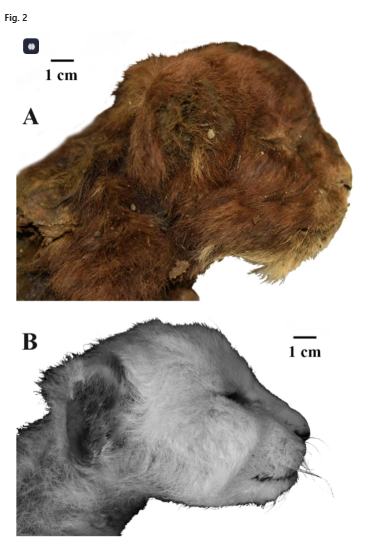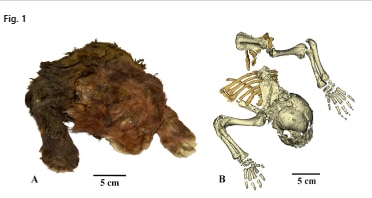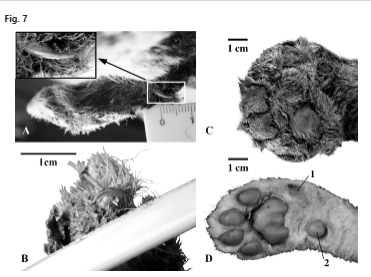Researchers, who examined the appearance of a 35,000-year-old frozen mummy of a newborn sabre-toothed cat, said the discovery of the extinct mammal cub “radically expands the understanding of distribution of the genus and confirms its presence in the Late Pleistocene in Asia”.
In a rare paleontological find, a team of seven researchers led by A V Lopatin from Borissiak Paleontological Institute and M V Sotnikova from Geological Institute, Russian Academy of Sciences, uncovered the mummy, identified as Homotherium latidens, in Siberia’s permafrost along the banks of the Badyarikha River in Yakutia in 2020.

The remains were found encased in ice alongside pelvic bones, a femur, and shin bones which contained the head and the anterior part of the body preserved approximately to the caudal edge of the chest. The felid cub, which was three weeks old at the time of its death, still has its whiskers and claws intact.
The discovery provided researchers with an opportunity to describe the physical characteristics for the first time including insights into the texture of their fur, muzzle shape, shape of the front paw, and muscle distribution.
According to the study published in the journal Scientific Reports on November 14, the examination of the cub’s appearance revealed notable differences compared to a modern lion cub of the same age, including an unusual muzzle shape with a large mouth opening, small ears, a robust neck, elongated forelimbs, and a dark coat colour.

 External appearance of three-week-old heads of large felid cubs, right lateral view: (A) Homotherium latidens (Owen, 1846), specimen DMF AS RS, no. Met-20-1, frozen mummy, Russia, Republic of Sakha (Yakutia), Indigirka River basin, Badyarikha River; Upper Pleistocene; (B) Panthera leo (Linnaeus, 1758), specimen ZMMU, no. S-210286; Recent.
External appearance of three-week-old heads of large felid cubs, right lateral view: (A) Homotherium latidens (Owen, 1846), specimen DMF AS RS, no. Met-20-1, frozen mummy, Russia, Republic of Sakha (Yakutia), Indigirka River basin, Badyarikha River; Upper Pleistocene; (B) Panthera leo (Linnaeus, 1758), specimen ZMMU, no. S-210286; Recent.
Why is the discovery important?
The discovery of the cub mummy alters our understanding of the species’ distribution by confirming its presence in the Late Pleistocene (Ice Age) in Asia, specifically in the region of Yakutia, Russia. Previously, the latest known occurrence of the Homotherium Latidens genus in Eurasia was recorded during the Middle Pleistocene, between 7,70,000 and 1,26,000 years ago, according to the study.
The findings from this well-preserved feline indicate that Homotherium Latidens survived longer than previously thought, extending its range into the Late Pleistocene, which spans from 1,26,000 to 11,700 years ago. “This finding is the second evidence of the presence of H. latidens in the Late Pleistocene of Eurasia and the first described find from Asia,” the study states.
 The frozen mummy of Homotherium latidens (Owen, 1846), specimen DMF AS RS, no. Met-20-1, Russia, Republic of Sakha (Yakutia), Indigirka River basin, Badyarikha River; Upper Pleistocene: (A) external appearance; (B) skeleton, CT-scan, dorsal view.
The frozen mummy of Homotherium latidens (Owen, 1846), specimen DMF AS RS, no. Met-20-1, Russia, Republic of Sakha (Yakutia), Indigirka River basin, Badyarikha River; Upper Pleistocene: (A) external appearance; (B) skeleton, CT-scan, dorsal view.
What were the findings?
While the mummy retained sharp claws and whiskers (or vibrissae), researchers observed that “the mummy’s eyelashes were not preserved”. “We focused on the analysis of the cranial (head) and dental features of the mummy to determine its taxonomic position. Among the postcranial elements, we analysed here only the most striking morphological peculiarities determined visually,” said the study.
Meanwhile, radiocarbon dating — decay of a radioactive isotope of carbon to determine the age of organic materials — of the mummy’s fur indicates that it has been entombed in permafrost for at least 35,000 years, with estimates suggesting it could be as old as 37,000 years.
The findings regarding the juvenile development of the skull and limbs provide insights into the unique “early postnatal growth of Homotherium”.
 Forepaws of three-week-old large felid cubs: A, B, С, Homotherium latidens (Owen, 1846), specimen DMF AS RS, no. Met-20-1, frozen mummy, right forepaw
Forepaws of three-week-old large felid cubs: A, B, С, Homotherium latidens (Owen, 1846), specimen DMF AS RS, no. Met-20-1, frozen mummy, right forepaw
What is a sabre-toothed cat?
Sabre-toothed cats, particularly those from the extinct genus Homotherium, were large carnivorous mammals that roamed various parts of the world during the Pliocene and early Pleistocene age. This genus thrived approximately between 5.3 million and 11,700 years ago, showcasing adaptation to their environments with distinctive physical features.
According to researchers, these cats are most famously recognised for their elongated, blade-like canine teeth, which extend from their mouths when closed, giving them their distinctive appearance. Fossil evidence indicates that they inhabited regions in North America, South America, Europe, Asia, and Africa during their prime.

